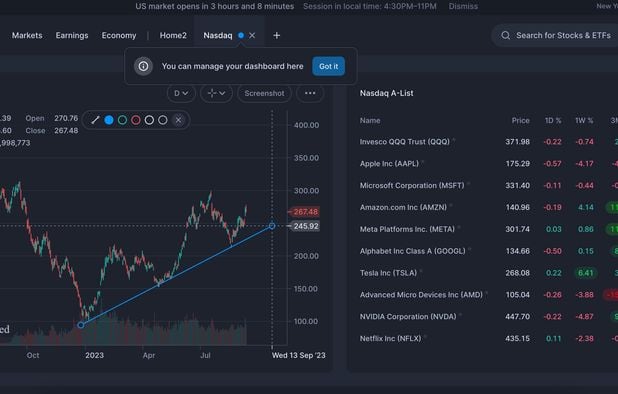The market coverage of trading platforms for AI analysis and prediction of stocks is crucial as it determines the assets and markets that you are able to access. Platforms that have a wide market coverage let you diversify your options and discover global opportunities and also adapt to a variety of trading strategies. Here are the top ten tips to assess the market cover of these platforms.
1. Evaluate Supported Asset Classes
Stocks: Ensure that the platform includes stocks from all major stock exchanges, including NYSE, NASDAQ and LSE.
ETFs. Make sure the platform offers a variety of ETFs, so you get diversified exposure.
Options and futures: Verify whether the platform supports derivatives such as options, futures, and other instruments that leverage.
Forex and commodities: Check if the platform supports forex pairs, precious-metals, energy commodities and agricultural products.
Cryptocurrencies: Make sure the platform supports major copyright (e.g., Bitcoin, Ethereum) and altcoins.
2. Check Coverage Area
Global markets - Check that the platform can to cover all major markets across the world including North America (including Canada), Europe, Asia-Pacific markets and emerging ones.
Regional focus Verify that the platform has a focus on certain markets or regions that coincide with your trading interests.
Local exchanges. Find out if the platform allows exchanges that are regional or local to your area.
3. Compare Real-Time and. delayed data
Real-time information - Make sure the platform offers live market data that can aid you in making quick decisions, particularly for active traders.
Delayed data: Find out whether you can obtain delayed data for free, or at a lower cost. This could be sufficient for long-term investors.
Data latency: Determine whether the platform is able to reduce latency in real-time feeds of data, particularly for high-frequency trading.
4. Evaluation of Historical Data
Depth historical data: Ensure whether the platform is able to provide extensive historical information (e.g. more than 10 years of data) for analysis and backtesting.
Find out the precision in historical data.
Corporate actions: Check if historical data accounts for dividends, stock splits, and other corporate actions.
5. Check the Market Depth and Place an Order Books
Data Level 2: Make sure the platform has Level 2 (order book depth), for better price discovery.
Bid-ask Spreads: Verify that the platform is showing real-time spreads between bid and request for the most precise pricing.
Volume data: Check if your platform has detailed volume data to analyze liquidity and market activity.
6. Review the coverage of Indices and Sectors
Major indices: Ensure that your platform can support major indices, like the S&P 500 (e.g. NASDAQ 100 or FTSE 100), for benchmarking based on indexes.
Information from specific industries: To perform a targeted analysis, you should determine if the platform has data for certain sectors (e.g. technology, health care, technology, etc.).
Customized indices. Find out if you are able to make or monitor custom indices according to your requirements.
7. Test the integration of News and Sentiment Data
News feeds - Ensure the platform integrates real-time news feeds for market-moving stories from reputable (e.g. Bloomberg or Reuters) sources.
Sentiment analysis Find out if your platform has sentiment analysis tools using social media data, news sources, or another data source.
Event-driven strategy: Check that the platform is compatible with the use of event-driven trading strategies (e.g. announcements of earnings, economic reports).
8. Verify Multimarket Trading Capabilities
Trading in cross-markets: The system should allow trading in different markets or asset classes with a single user interface.
Conversion to currencies: Make sure the platform allows multi-currency trading and automated conversion of currencies for international trading.
Support for time zones: Verify whether your platform permits you to trade in different time zones.
9. Check the coverage of other data sources
Alternative data: To gain unique insights, check if your platform uses other data sources (e.g. satellite imagery, web traffic or credit card transactions).
ESG data. Verify whether the platform contains socio-economic, environmental and governance data for socially responsible investing.
Macroeconomic Data: Check whether the platform contains macroeconomic indicators like GDP, inflation and interest rates.
Review Market Reputation and User Reviews
User feedback is a great method of evaluating the market the platform's coverage.
Reputation in the industry: Check whether the platform has been recognized by industry experts in terms of market coverage.
Case studies: Look for testimonials or case studies that highlight the platform's success in specific assets or markets.
Bonus Tips
Trial period for free: Try the coverage in the marketplace of the platform as well as its data quality by using the demo or trial for free.
API access: Check whether the platform's API permits access to market data programmatically for custom analysis.
Customer Support: Ensure that the platform is able assist with any data-related or market-related issues.
The following tips can help you assess the market coverage of AI stock-Predicting/Analyzing trading platforms. You'll be able to select one that offers access to market data and markets for efficient trading. You can broaden your portfolio and take advantage of new opportunities using a comprehensive market coverage. Take a look at the top rated ai investing platform blog for site tips including AI stock trading bot free, trading with ai, ai for investing, ai chart analysis, ai chart analysis, ai trading tools, ai for stock predictions, chatgpt copyright, investment ai, ai investing and more.

Top 10 Ways To Evaluate The Reputation, Reviews And Reviews Of Ai Stock Trading Platforms
To ensure trustworthiness, reliability and efficiency, it's crucial to examine the reputation and reviews of AI-driven prediction and trading platforms. Here are the top 10 ways to assess reputation and reviews.
1. Check Independent Review Platforms
Tips: Search for reviews on trusted platforms such as G2, copyright, or Capterra.
The reason is that independent platforms allow users to give honest feedback.
2. Study user testimonials and case research
Users can read user reviews or case studies by visiting the platform's own website, and also on third-party sites.
What they do: They give insight into real-world performance customer satisfaction, performance and similar.
3. Review of Expert Opinions, Industry Recognition
Tip: Check if industry experts or financial analysts from reputable publications have been recommending or reviewing the platform.
Expert endorsements lend credibility to claims made by the platform.
4. Social Media Sentiment
Tips Watch social media sites like Twitter, LinkedIn and Reddit to see what other users are saying about them.
Social media allow you to get the honest opinions of people and the latest trends.
5. Verify Regulatory Compliant
Verify that the platform you are using is compliant with the financial regulations (e.g. SEC, FINRA) as well as privacy regulations (e.g. GDPR).
What's the reason? Compliance ensures that the platform is operating legally and ethically.
6. Make sure that there is transparency in performance Metrics
Tip: Look for transparent performance indicators on the platform (e.g. accuracy rates and ROI).
Transparency builds confidence and allows users of the platform to determine its efficacy.
7. Take a look at the Customer Support Quality
Tips: Read customer reviews about the platform and their ability to provide assistance.
Support that is reliable is crucial to solving problems with users and ensuring a positive overall experience.
8. Look for Red Flags in Reviews
Tip: Pay attention to complaints that are recurrent like ineffective service, hidden fees or the absence of updates.
Consistently bad feedback can indicate that there is a problem in the system.
9. Examine User Engagement and Community Engagement
Tips: Find out if the platform engages with its users regularly and has a vibrant community.
The reason: A strong community indicates user satisfaction and ongoing support.
10. Check out the track record of the company
Explore the past performance of the company as well as its leadership as well as the performance of the financial technology sector.
Why: A proven track record increases trust and confidence on the platform.
Compare Multiple Platforms
Compare the reputation and reviews of various platforms to figure the one that is most suitable for you.
By following these guidelines It is possible to evaluate and review the reputations and opinions of AI-based trading and stock prediction solutions to ensure that you select the most reliable and effective solution. Follow the top how to use ai for stock trading examples for website recommendations including AI stock price prediction, stock predictor, ai options, ai tools for trading, chart analysis ai, best ai for stock trading, ai tools for trading, stock trading ai, ai options, AI stock predictions and more.
